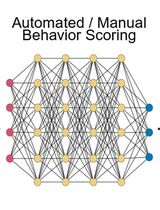- EN - English
- CN - 中文
Conditioned Lick Suppression: Assessing Contextual, Cued, and Context-cue Compound Fear Responses Independently of Locomotor Activity in Mice
条件性舔抑制:评估独立于小鼠运动活动的情境、线索和情境线索复合恐惧反应
发布: 2022年12月05日第12卷第23期 DOI: 10.21769/BioProtoc.4568 浏览次数: 1429
评审: Edgar Soria-GomezNanci WinkeAnonymous reviewer(s)
Abstract
Pavlovian fear conditioning is a widely used procedure to assess learning and memory processes that has also been extensively used as a model of post-traumatic stress disorder (PTSD). Freezing, the absence of movement except for respiratory-related movements, is commonly used as a measure of fear response in non-human animals. However, this measure of fear responses can be affected by a different baseline of locomotor activity between groups and/or conditions. Moreover, fear conditioning procedures are usually restricted to a single conditioned stimulus (e.g., a tone cue, the context, etc.) and thus do not depict the complexity of real-life situations where traumatic memories are composed of a complex set of stimuli associated with the same aversive event. To overcome this issue, we use a conditioned lick suppression paradigm where water-deprived mice are presented with a single conditioned stimulus (CS, a tone cue or the context) previously paired with an unconditioned stimulus (US, a foot shock) while consuming water. We use the ratio of number of licks before and during the CS presentation as a fear measure, thereby neutralizing the potential effect of locomotor activity in fear responses. We further implemented the conditioned lick suppression ratio to assess the effect of cue competition using a compound of contextual and tone cue conditioned stimuli that were extinguished separately. This paradigm should prove useful in assessing potential therapeutics and/or behavioral therapies in PTSD, while neutralizing potential confounding effects between locomotor activity and fear responses on one side, and by considering potential cue-competition effects on the other side.
Graphical abstract

Schematic representation of the compound context-cue condition lick suppression procedure. Illustration reproduced from Bouchekioua et al. (2022).
Background
Pharmacological treatments for PTSD, such as the 5-HT2CR antagonist SB242084 (Browne et al., 2017), increase locomotor activity and could alternatively explain the reduction of fear responses when measuring the time spent in freezing. The potential locomotor activity confounding variable has thus to be neutralized before drawing any conclusion regarding the role of a treatment in fear responses.
Exposure therapies developed to treat PTSD consist of gradually confronting patients to stimuli that are identified as triggers of the symptoms; yet patients do not necessarily have conscious access to these triggers. Moreover, according to associative learning theories, the intensity of fear responses to stimuli can be affected in situations where multiple conditioned stimuli (CSs), previously paired with the same aversive event, interact (Kamin, 1969; Rescorla and Wagner, 1972; Mackintosh, 1974; Pearce and Hall, 1980). It has been shown that a reduction in fear responding to a cue is associated with sustained contextual fear responses when cue-specific and contextual information are combined during conditioning, but tested separately (Grillon et al., 2002; Baas et al., 2008; Baas, 2013). Underestimating cue-competition effects may thus lead to an incomplete evaluation of potential therapeutics.
To overcome these limitations and improve the screening efficiency of candidate drugs in fear conditioning, we propose a condition lick suppression procedure to assess contextual, cued, and context-cue compound fear responses.
Materials and Reagents
Black opaque acrylic or plastic sheet (height: 18 cm; width: 6 cm; thickness: 2 mm)
Triangular-shaped ceiling made with two transparent acrylic sheets (21.5 × 13 cm, 1 mm thick) (YSTIME, catalog number: B08NPMVJGQ)
Transparent acrylic hinges (IVYTOHO, catalog number: B07SMSJJK2)
0.5 mm thick high-density white polyethylene plastic sheet (Polymersan, catalog number: 0714038308181)
40 × 40 × 40 mm urethan rubber block (Tokyu Hands, catalog number: 4989606010889)
Solder wire (Editone, Adafruit, catalog number: SAC305)
Hook-up wire spool set, 22AWG solid core, 10 × 25 ft (Adafruit, catalog number: 3174)
Momentary push button switch NO NC AC 5 A/120 V (DIYhz, catalog number: B079D923V9)
DB9 D-SUB RS232 Adapter 9 pin signals terminal breakout plastic cover 2 row (male with screw) (Daier, catalog number: B01C2V2E8BU)
IR break beam sensors with premium wire header ends, 3 mm LEDs (Adafruit, catalog number: 2167)
MPR121 12 key capacitive touch sensor breakout (Adafruit, catalog number: B0778WYR5D) [Alternative: Adafruit 12 × capacitive touch shield for Arduino – MPR121 (Adafruit, catalog number: 2024)]
Adafruit LED Sequins [luminous intensity: minimum = 250 mcd and maximum = 350 mcd with IF (Forward Current) = 20 mA; luminous intensity measurement allowance is ± 10%], warm white (Adafruit, catalog number: 1758)
Speaker 8Ω8W (Akizukidenshi, catalog number: F00805)
Amazon Basics USB 2.0 printer cable – A-Male to B-Male cord (Amazon Basics, catalog number: B00NH11KIK)
White cotton/polyester knit gloves (Setaria Viridis, catalog number: B08QHLCZ11)
Double sided tape (3M, catalog number: 0888519024546)
Alligator to Dupont wire (Oiyagai, catalog number: B07CXLMBY7)
Adult mice (8-week-old to 18-week-old)
70% ethanol solution
Equipment
Modular chamber (Lab-hacks, model: STCHK0001)
Watering bottle with rubber stopper and water tube (CLEA Japan, catalog number: CL-0917)
Sound attenuating cubicle for mouse (Med associates, model: MED-OFA-022)
Standalone aversive stimulator/scrambler (115V/60Hz) (Med associates, model/catalog number: ENV-414S) [Alternative: Precision animal shocker (Coulbourne Instruments, Harvard Apparatus, catalog number: H13-15)]
Arduino Mega2560 Rev3 (Arduino, catalog number: A000067)
Raspberry Pi 3 model B+ [Raspberry Pi, catalog number: (Digi-Key)2648-RASPBERRYPI3MODELB+-ND]
Digital Genuine Hakko with a standard T18-D16 tip (Hakko, catalog number: FX-888D)
Software
Arduino IDE (Arduino, https://www.arduino.cc/en/software)
Anaconda (Anaconda, https://www.anaconda.com/)
Spyder IDE (Included in Anaconda, https://www.spyder-ide.org/)
Python 3 (https://www.python.org/downloads/)
Python libraries: pyserial 3.5 (https://pyserial.readthedocs.io/en/latest/pyserial.html); csv, time, and os modules are part of Python’s standard libraries
Excel (Microsoft, https://www.microsoft.com/fr-ww/microsoft-365/excel)
Prism 9 (GraphPad Software, https://www.graphpad.com/company/)
SPSS 23.0 (IBM, https://www.ibm.com/analytics/spss-statistics-software)
Arduino and Python scripts (https://github.com/YuYuB/Bio-Protocol-ConditionedLickSuppression)
Procedure
文章信息
版权信息
© 2022 The Authors; exclusive licensee Bio-protocol LLC.
如何引用
Bouchekioua, Y., Nishitani, N. and Ohmura, Y. (2022). Conditioned Lick Suppression: Assessing Contextual, Cued, and Context-cue Compound Fear Responses Independently of Locomotor Activity in Mice. Bio-protocol 12(23): e4568. DOI: 10.21769/BioProtoc.4568.
分类
神经科学 > 行为神经科学 > 学习和记忆
神经科学 > 神经系统疾病 > 动物模型
您对这篇实验方法有问题吗?
在此处发布您的问题,我们将邀请本文作者来回答。同时,我们会将您的问题发布到Bio-protocol Exchange,以便寻求社区成员的帮助。
提问指南
+ 问题描述
写下详细的问题描述,包括所有有助于他人回答您问题的信息(例如实验过程、条件和相关图像等)。
Share
Bluesky
X
Copy link












